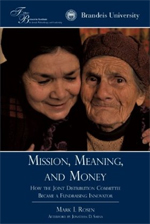Mark Rosen pulls back the curtain on the Joint Distribution Committee
He provides an inside look at how the JDC became a fundraising innovator

Mark I. Rosen
The American Jewish Joint Distribution Committee (JDC), a global humanitarian organization, is a fundraising powerhouse; the JDC raises more than $100 million annually from a variety of sources. This figure is even more impressive, though, when you consider that the organization, which originally operated solely on funds provided by the North American system of Jewish Federations, didn’t begin its own development phase until the late 1990s. In his new book, “Mission, Meaning, and Money: How the Joint Distribution Committee Became a Fundraising Innovator,” Mark I. Rosen of the Hornstein Jewish Professional Leadership Program explores how the JDC was able to establish such a successful fundraising operation in a comparatively short amount of time. He says the group’s story can provide valuable survival information for any non-profit.
BrandeisNOW: Why did you decide to write about the JDC, and why now?
Mark Rosen: This was a project that was initiated by the Fisher-Bernstein Institute of Jewish Philanthropy and Leadership when I was a researcher there. We had written a previous case study of another Jewish organization, and the JDC, or “Joint” as it's known to insiders, was particularly interesting because it is deeply embedded in the infrastructure of the Jewish institutional world; it’s been around since 1914, and it’s the largest Jewish nonprofit in the United States, operating in 70 countries with a budget in excess of $300 million. So if you’re interested in Jewish philanthropy, this is the Rolls Royce of institutions to examine.
BrandeisNOW: Given its wide scope, how did you approach telling the JDC story?
MR: Once the JDC gave us access, it was a matter of setting up interviews with key people, like top leadership and staff, as well as board members and the primary donors outside of the organization. I ended up doing 83 interviews over the course of several years, and reading everything I could find about the organization.
Through these interviews, I learned about all of the amazing things the JDC does, even though the general public knows very little about it. The Joint is the Jewish world’s 911 for international Jewry. It provides relief, rescue and renewal services around the world. So if there’s a flood in Romania, and there’s a Jewish community that’s affected, the Joint will come in with food, clothing, temporary shelter, medical supplies, and so on. So in that sense, it’s very much like other international relief organizations, such as the Red Cross, but what the Red Cross doesn’t do is rescue Jews in danger. There was a situation recently where some Jews in Yemen were under attack and needed to be rescued, and that is also something the Joint gets involved in. Historically, there have been many instances—Yugoslavia during the Bosnian war, Syria where Jews were in danger and somebody had to rescue them- and the JDC organized clandestine missions to get Jews out.
There is also an element of Jewish renewal, where the JDC offers programs to Jewish communities that may have lost their connection to Judaism, and helps to re-establish it.
For many years, the Jewish federation system, the American philanthropic structure that supports the whole Jewish institutional infrastructure, basically supplied all their money, so the Joint didn’t have to do fundraising; they just got a check in the mail. The Jewish federation system essentially divides up the money that is designated for overseas Jewry according to a three-to-one ratio, where for every dollar raised, 75 cents goes to the Jewish Agency for Israel, and 25 cents goes to the JDC. That was the system for a long time, but it stopped working for the JDC following the collapse of the former Soviet Union. All of the sudden there were millions of Jews who had been cut off from the rest of the Jewish world, and they needed all kinds of support. The JDC calculated that it would need an extra $90-100 million a year to meet these needs, and they saw that they weren’t going to get if from the Jewish federations, so they started a fundraising operation.
The book really describes that process of how they went from being an organization that didn’t do any fundraising, but suddenly has to raise a lot of money. And they became very successful at it. The real value of the book is not just for Jewish nonprofits, but also for any nonprofit. How do you go from essentially 0 to $120 million a year in 10 years? The way the JDC did it was with the leadership of a man named Alan Gill, who had some innovative ideas about how to build relationships with donors, and how the JDC’s culture itself needed to change as well. At the same time, though, the principles don’t reside in any person. It’s just really smart fundraising, and there’s a lot to learn from what Gill and the development staff did.
BrandeisNOW: There’s been some tension recently between the Joint and the Jewish Agency regarding how the Jewish federation system distributes its money. What is the potential impact that could have on the JDC?
MR: Going back to the 1920s, there was a tension over how the money collected from Jews in America would be spent overseas. Jewish federations collect money for charitable Jewish causes. While some of that money is used locally, some goes overseas. So there was always this tension regarding overseas allocations. Should the money go to Israel primarily, or should it go everywhere else? You had some fierce battles in the 1920s, ‘30s and ‘40s, always over how to split the money. During WWII with everything going on there, and then after, when hundreds of thousands of survivors of the Holocaust needed to be housed, fed, and receive medical care, the money went primarily to the Joint. But then Israel was born in the late ‘40s, and now all of a sudden, Europe is the past, Israel is the future. While the JDC was focused internationally, the Jewish Agency was concerned with immigration to Israel. By the early 50s, the Jewish federation system institutionalized the split of 75 percent to the Jewish Agency and 25 percent to the JDC that is now still in effect
But now here we are almost 60 years later, and immigration to Israel has slowed down. There are hundreds of thousands of Jews that need services in the former Soviet Union, and yet, the split formula of money is still the same. In the past few months, the JDC has been more vocal about saying that this doesn’t make any sense anymore, the formula must be changed so that it reflects needs in the world, rather than past political ideologies. At the same time, the Jewish Agency is now talking about changing its mission, so that rather than being focused on immigration to Israel, it will now focus on the building of Jewish identity around the world.
These are very recent events that my book doesn't address. But what the book basically tells the story of is how did we get here? What is all the history that led to these current conflicts? Anybody who wants to understand that debate will find my book to be very useful background.
BrandeisNOW: Has JDC fundraising remained strong even as other non-profits are hurting because of the economic crisis?
MR: The JDC’s core money from the Jewish federation system has been going down every single year as donations due to the economic situation go down. And that core money is their oxygen. I think that’s the reason that they’ve taken on this new stance of challenging the status quo, because their ability to operate as an organization is becoming imperiled as the core money keeps shrinking. So, yes, the economic downturn has affected them, but they’re still doing a lot -- they’ve just had to cut back in various places, they’ve laid staff off, they’ve identified tens of thousands of welfare recipients who will no longer be receiving their aid, which is very painful.
I think the thing that the Jewish world needs to recognize is that this is an extremely sophisticated, professional, creative organization, because their whole existence is about adapting to new realities. And anything they take on, they do extremely well. So if they take on a new fundraising direction there is going to be an impact. Right now, we’re reading in the Jewish press that the JDC is talking about challenging the federation system where they had a gentlemen’s agreement that they would not compete with annual campaigns. What that means is, they don’t go into cities to fundraise without first working with the local federation. Now some of these individual local federations are not really giving that much money to overseas allocations, and yet the JDC is still beholden to the gentlemen’s agreement. So I think there’s some conversation about changing that. If they do that, they’re going to do it extremely well, I have no question whatsoever about their new direction and ability to execute it well, which might be threatening to some institutions in the Jewish world because whatever the JDC does, they’re going to be good at it.
And this is where my book can potentially help these smaller non-profits. It’s basically pulling the curtain back, and revealing what’s going on at the JDC. This is all written from talking to the people who did it, and getting their story and then synthesizing it all and telling it.
 BrandeisNOW: What’s been the JDC’s response to your book?
BrandeisNOW: What’s been the JDC’s response to your book?
MR: I think that this is one of those stories that doesn’t get told unless someone takes the time to tell it. So I think they’re pleased that this story is being told. Because this is an organization that really keeps a very low profile, for a number of reasons. Number one, some of what they do is clandestine, so they don’t like calling attention to themselves. Number two, they just don’t have a culture of self-promotion. They do their work and they do it quietly, sometimes they get credit, sometimes they don’t. And I think that’s just the way they operate: very mission-focused. I didn’t know a lot about the organization when I took on the project, and you can’t help but develop an enormous amount of respect for what they do. Once you learn about the work of JDC, as an American, you really feel compelled to want to support them because the work is really is so meaningful and inspiring. From all indications, they thought I told their story well.
BrandeisNOW: Anything else that you want to add about the book?
MR: Well, I wrote it with the hint of suspense novel-writing style. I didn’t want it to be a dry academic book, because it’s such a vivid story, It starts out in WWI when Turkey is aligning with Germany and Jews in Palestine are being persecuted, and need help, which is when the Joint was created. The story the book tells is intertwined with the history of the 20th century and the history of the Jewish people, and every time some tragedy befalls the Jewish people, the Joint is there, and just telling that story was fascinating. Even if the subject matter of fundraising wouldn’t necessarily grab somebody if they saw it on the shelf at their local bookstore, I think people who read it will find it’s a really interesting story about an utterly unique organization.





